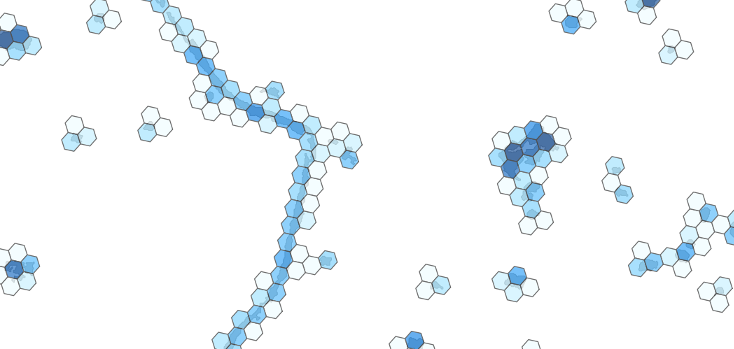PostgreSQL extension for the H3 hierarchical geospatial indexing system
This extension integrates with the PostGIS geometry type. Namely Point, Polygon and MultiPolygon geometries are supported.
To see the functions implemented in this extension please refer to the SQL API.
Compile H3 as a shared library. The source is available on github, there are als o detailed instructions for building H3 available in that repository, but to make H3 work with this extension there are additional build flags required. There are essentialy two ways to compile H3 which allow building the pgh3 extension later.
Compile H3 as a static library. This allows statically linking H3 to the pgh3 extension.
cmake -DCMAKE_C_FLAGS=-fPIC .
make
sudo make install
Or compile H3 as a shared library. This creates a dynamically loaded library which may also be used by other programs. When you update the H3 library, all programms using it will automatically use the new version (PostgreSQL needs to be restarted for that).
cmake -DBUILD_SHARED_LIBS=1 -DCMAKE_INSTALL_PREFIX:PATH=/usr .
make
sudo make install
In case you have set up your LD_LIBRARY_PATH for PostgreSQL to also look in /usr/local for libraries, you can ommit the -DCMAKE_INSTALL_PREFIX:PATH=/usr switch.
Compile the pgh3 extension:
make
sudo make install
Run the tests (this is an optional step):
make installcheck
Before using this extension, it needs to be added to the databases using postgresqls CREATE EXTENSION command:
create extension postgis; -- dependency of pgh3, must be created first
create extension pgh3;
For usage examples see the unittests in the sql/*_test.sql files.
This extensions allows configuring some parts of its behaviour. This configuration is done using additional keys to postgresql.conf
The H3 polyfill function requires a preallocation of the memory for the generates indexes. Depending of the size of the
given polygon, its shape and the resolution this may exhaust the memory given to this extension. In this case
this function will be terminated by the database server and a corresponding notice will be given.
This memory limit can be increased using the pgh3.polyfill_mem configuration parameter in the postgresql.conf file. The
default value for this setting 1024MB (PostgreSQL internal MaxAllocSize). Syntax for the setting is
pgh3.polyfill_mem = 1024MB
For values larger than MaxAllocSize, the PostgreSQL MemoryContextAllocHuge allocator will be used.
This setting is only available when using a PostgreSQL version >= 10. On earlier versions the memory limit is set to 1024MB.
Most errors emmitted by this extension are making use of the PostgreSQL error codes.
This allows a more explicit handling of certain errors in application code or PL/pgSQL procedures. To give a short example using the psql command line:
h3=# \set VERBOSITY verbose
h3=# select count(*) from h3_polyfill(st_geomfromtext('POLYGON((30 10,40 40,20 40,10 20,30 10))'), 10);
ERROR: 53400: pgh3.polyfill_mem: requested memory allocation (7.58GB) exceeded the configured value (1023MB).
CONTEXT: PL/pgSQL function h3_polyfill(geometry,integer) line 4 at RETURN QUERY
LOCATION: __h3_polyfill_palloc0, util.c:158
Looking at he PostgreSQL documentaion, error code 53400 stands for configuration_limit_exceeded.
- Implement more parts of the H3 API
- Use the
numeric-type for H3 indexes?
This software is licensed under the Apache 2.0 License.
(c) 2018 German Aerospace Center (DLR); German Remote Sensing Data Center; Department: Geo-Risks and Civil Security

